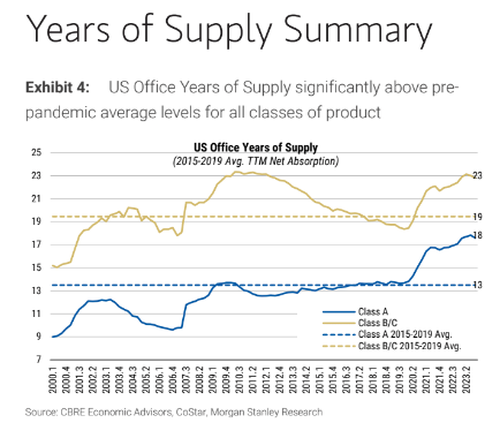There have been mounting concerns recently that the unfolding commercial real estate crash is accelerating and has rippled across the global financial system. From New York Community Bancorp to Japan’s Aozora Bank Ltd. and Germany’s Deutsche Pfandbriefbank AG, sizable credit losses and/or write-downs of US CRE debt have plunged some lenders into turmoil.
Lenders heavily invested in US CRE debt are facing significant challenges that will persist for a long time. Vishwanath Tirupattur, global head of Quantitative Research at Morgan Stanley, warned about this in a note last week.
Now Bloomberg reports brokers have begun to sell debt secured by office buildings in Manhattan, owned by Blackstone Inc., at a staggering 50% discount. A prime-time tower in Los Angeles was auctioned off in December, fetching 45% lower than its purchase price a decade ago. Additionally, the Federal Deposit Insurance Corp. has recorded a 40% loss on $15 billion worth of loans it disposed of, secured by apartment buildings in New York City.
The fallout will worsen because the bubble unwinding in the CRE market is a byproduct of a decade of rock-bottom rates that forced investors out of safe assets like bonds into risky CRE debt.
Last week, Treasury Secretary Janet Yellen said CRE losses are concerning but comforted investors with the understanding the situation is “manageable.” Meanwhile, real estate investor Barry Sternlicht, chairman and CEO of Starwood Capital, has a more dire outlook, warning about trillion-dollar office losses.
“The office market has an existential crisis right now… it’s a $3 trillion dollar asset class that’s probably worth $1.8 trillion [now].”
Scott Rechler, chief executive officer of New York landlord RXR, recently told Bloomberg:
“In 2024, we’re at that fifth stage of grief” for the CRE space, adding, “People are now in acceptance.”
CRE turmoil has rocked domestic and overseas banks:
As of December, offices accounted for 41% of the US’s nearly $86 billion worth of distressed properties, as per MSCI data. The term “potential distress,” indicating a decline in the financial health of assets, is approaching $235 billion across various types of properties.
Office and apartments account for the bulk of distressed US property.
Doom and gloom continued with a new CRE note from Morgan Stanley, warning that “years of supply” of office tower space will be the “greatest headwind” that will continue to exert downward pressure on prices.
Analysts led by Ronald Kamdem and Adam Kramer show years of supply for Class A and Class B offices are currently well above pre-Covid averages.
Our analysis suggests there is significant supply risk for the office sector in 4Q23 at the national level with current years of supply for both Class A and Class B/C (18 and 23 years, respectively) well above the pre-pandemic averages (13 and 19 years , respectively) — see Exhibit 5 . While the supply risk picture at the national level remains concerning and implies vacancy rates will likely remain under pressure, we acknowledge that REIT-specific takeaways remain more nuanced given substantive regional and market-specific differences
Considering the warnings from analysts regarding supply, the chaos in the CRE sector will persist. Recent information from Trepp indicates that over a trillion dollars in CRE loans are due for maturity by the end of next year.
Loading…
This post was originally published on this site
The post “Greatest Headwind” Facing US Office CRE Sector Is “Years Of Supply” appeared first on Nemos News Network.
 RSS Feed
RSS Feed













 February 14th, 2024
February 14th, 2024  Awake Goy
Awake Goy 



 Posted in
Posted in  Tags:
Tags: 
















